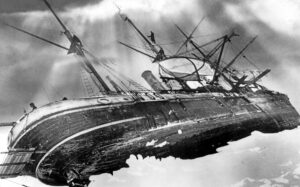Last month we traced the course of the ill-fated Donner Party as their wagon train attempted to cross the Sierra-Nevada mountains and reach a place they considered to be paradise: it was California. After being stuck for three months in cabins near Lake Truckee, 44 of the 89 emigrants did reach “paradise”—but it wasn’t the one they expected. Those poor souls died of disease and starvation in spite of the fact that they had some supplies including a few horses and cattle, endless firewood, and a trout-filled lake. They were on a well-known trail and had to do little more than “shelter in place” for four months until they would be rescued. But, because of the indecisive leadership and mistakes of George Donner, half of the party died.
Contrast that with the trans-Antarctic expedition led by Sir Ernest Shackleton. Their ship, the Endurance, was caught in the ice on January 10, 1915 and remained stuck until it was finally crushed on October 28, 1915. With their ship gone, Shackleton and his men set up camp on the ice for five and a half months. When the ice finally broke up in April, 1916, they launched three salvaged lifeboats and rowed for seven days and nights to reach Elephant Island.
Elephant Island takes its name from its shape. There are no elephants there. In fact, there is nothing there: no trees, no grass and no shelter. There is no harbor and ships never go near the place. Shackleton knew his men would never be rescued.
A week after they landed, Shackleton selected five men to go with him in one of the lifeboats that had been jury-rigged with a deck and sail. They sailed across 900 miles of open ocean to South Georgia Island where there was a whaling station. After enduring horrific conditions they landed but their troubles were not over. The whaling station and hope of rescue was on the other side of the island, and the prevailing wind and current made it impossible to sail there. Shackleton made a camp for three of the weakest men, left what supplies he could, and took the two strongest men with him. Together they hiked over the mountains and glaciers of the unexplored interior.
Back on Elephant Island, the remaining members of the crew lived in a hut made from two overturned lifeboats and some canvas. Finally, four and a half months after he reached the whaling station, Shackleton was able to get a ship to take him back to Elephant Island. Every member of the crew, and every member of the rescue party survived and returned home.
How is such a thing possible? The difference was in the leadership. According to the Donner survivors, “People gave up; pined away and died.” With weak, ineffectual leadership, they adopted an attitude of, “Every man for himself.” On the other hand, the Shackleton expedition was marked by strong leadership and a commitment to teamwork, shared responsibility and shared danger. Everyone worked for the common good.
The rules for that kind of leadership are easy to define, but difficult to live.
- A good leader must walk the walk, not just talk the talk.
- A good leader must influence without manipulating.
- A good leader is not afraid of ideas; is not afraid to have others participate equally and openly.
- A good leader backs up opinions with facts.
- A good leader is a real person—not simply a “persona.”
What kind of leader are you? What would you like to be?
Sign up for the two-day Academy of Yachting seminar led by experienced, licensed professionals where ideas on leadership, protocol and legal problems are discussed and dissected. Every club should require incoming flag officers to attend the Academy!



Leave a Reply